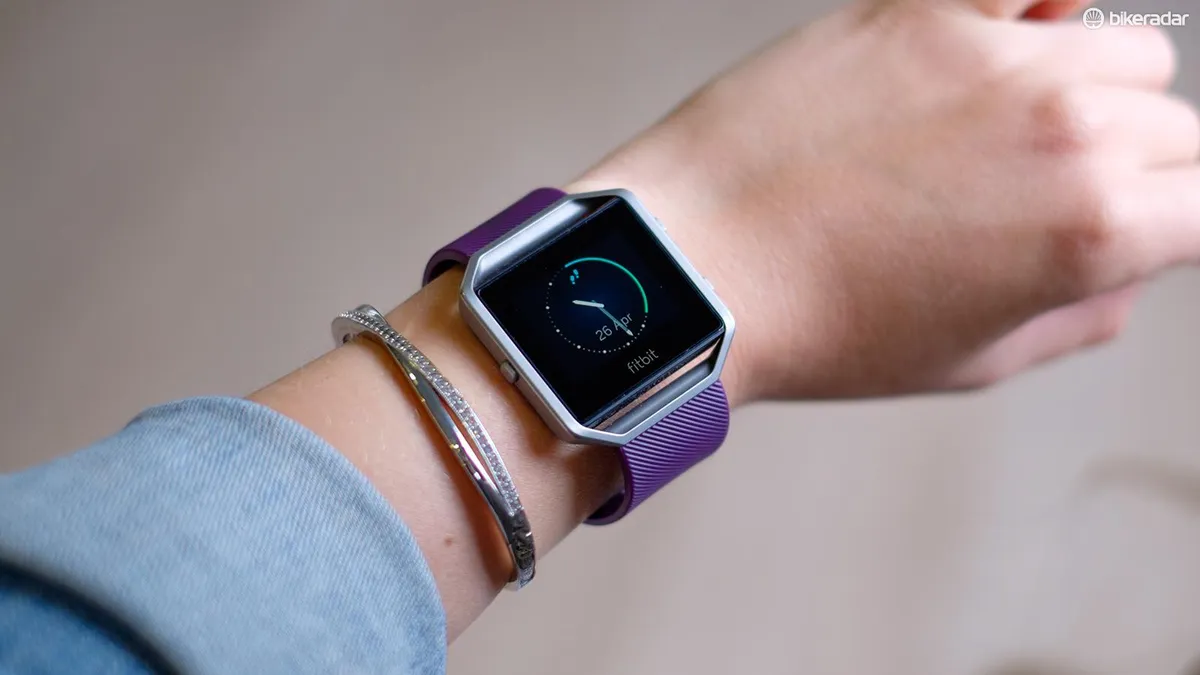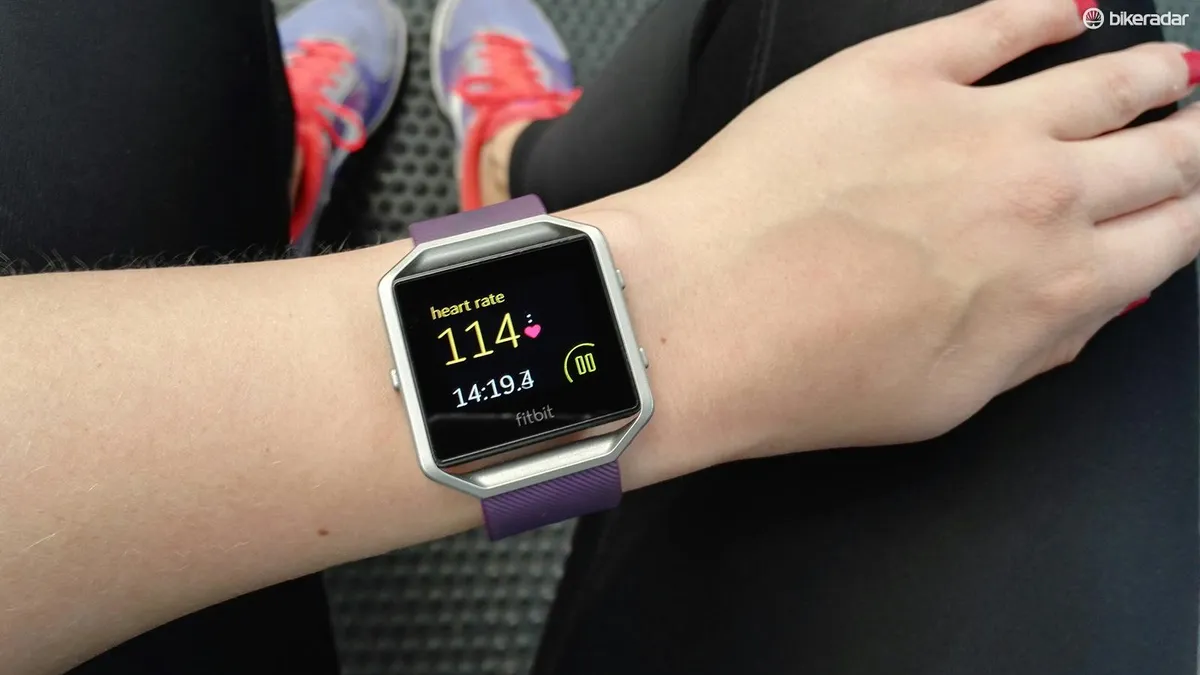The Blaze is a recent addition to the Fitbit wearable fitness tracker family. While lower-priced models in the range are wristbands designed for tracking activity and sleep, the Blaze is pitched as a smart fitness watch. It boasts features such as PurePulse Heart Rate, connected GPS, call and text notifications, calendar alerts, music control and on-screen FitStar workouts.
- Is the new Fitbit Blaze any good for cyclists?
- Fitbit Surge with wrist heart-rate detection auto-uploads to Strava
- Heart-rate monitor training for cyclists
Straight out of the box you get a USB charging cradle, the tracker unit itself and a sports band. There's no manual included but the setup is extremely straightforward, around 10 minutes in total, and on your mobile afterwards, you'll be taken through the basic care and operation with the Blaze 101 guide.
Design and wear
The Blaze is the first fitness wearable in Fitbit’s range with a colour LCD touchscreen, and (unlike the Surge fitness super watch) it can be accessorised with different wristbands, frames and clock faces, placing the Blaze in a prime position for being one of the more fashionable fitness trackers.
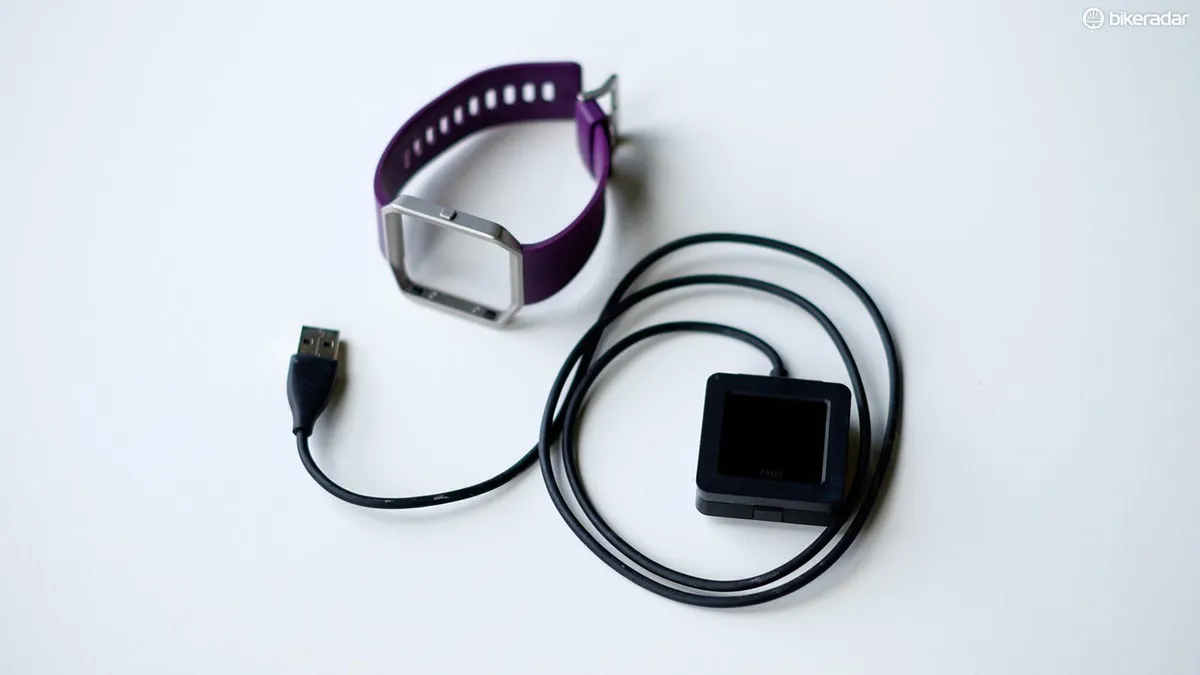
The elastomer sports band which comes as default is just under an inch wide, approximately 2mm in thickness, and has a ribbed texture. Prolonged wear of this particular band seemed to cause irritation to my skin, which was aggravated further when I wore it beneath a tight cycling jacket or during the night. Following the product care recommendations of loosening the band outside of exercise wear and regularly cleaning the strap did go some way to remedying this but my guess is that buying an alternative strap, maybe the luxe leather band, would solve the problem. I did find though that after a few weeks of wear, and occasionally switching which wrist I wore it on, the irritation died down.
The tracker itself is a removable unit contained within a stainless steel frame. To charge the Blaze, you pop the tracker unit into its charging cradle, with a full battery only requiring a 2hr charge.
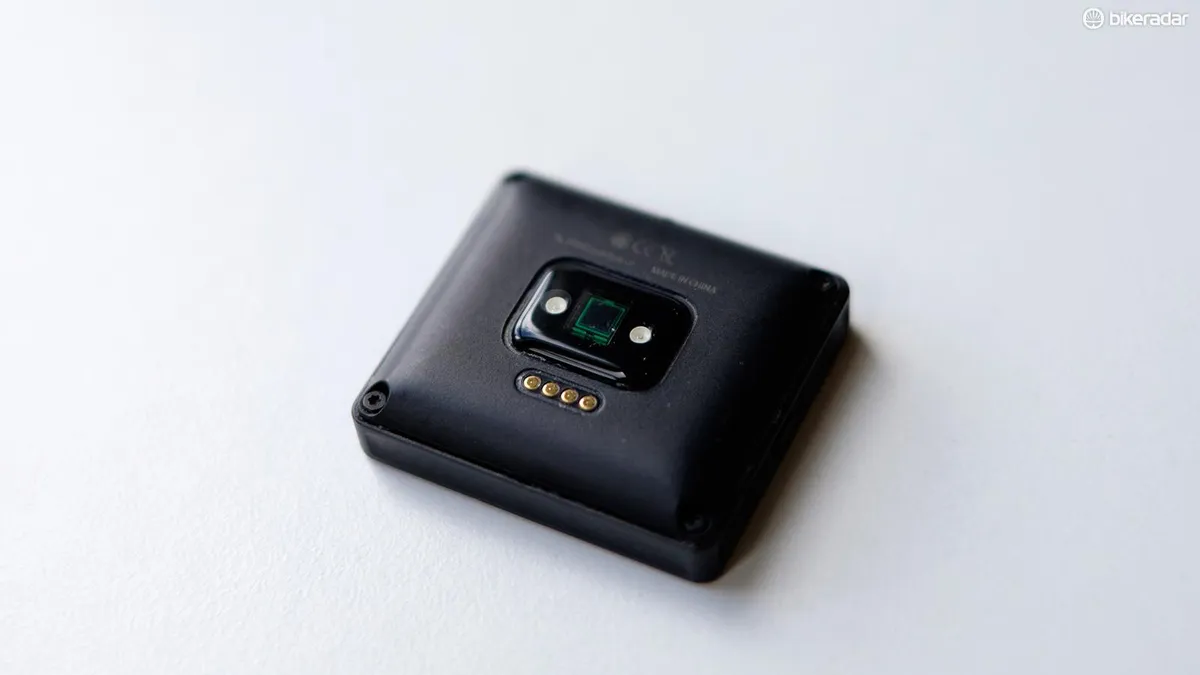
Even with auto HR tracking on all day, plus notifications and daily use of connected GPS, I got an impressive four days worth of juice – below the five days Fitbit states in the product spec, but more than I was expecting from a device that seems to offer so much.
Heart-rate monitoring
PurePulse, or continual heart rate tracking via wrist-based optical sensors, seems to perform well for steady state exercises such as cycling, running and walking. For the most part, my HR data seemed accurate given my age and current fitness level.
Ramping up the tempo with high intensity interval training is where the Fitbit Blaze fell short. Checking the watch mid-sprint interval showed my heart rate to be 150-155bpm, whereas my Polar chest strap readings were between 163-167bpm. Clearly I'm not the only one struggling to keep up the pace.
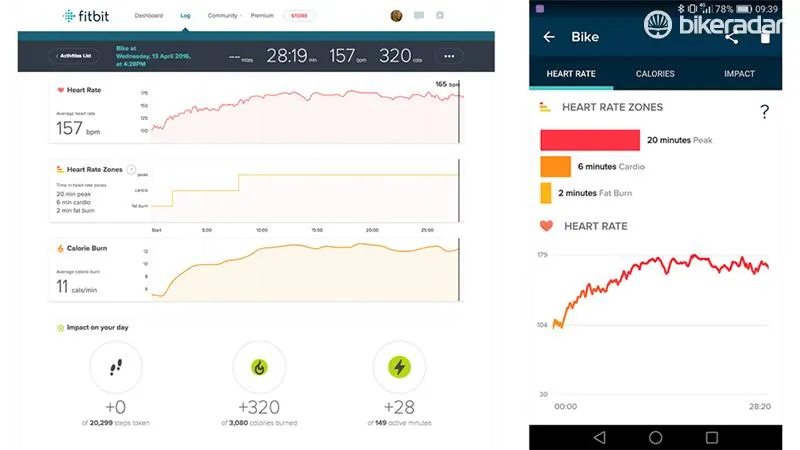
Fitbit explains in its heart-rate FAQs that non-rhythmic movements and high intensity exercise may prevent the sensor from giving an accurate heart rate reading, as will wearing the strap too tight, too loose or not in the correct position on your wrist.
Wearing while riding over more rugged terrain can also be somewhat problematic if you have small wrists. I found the watch would keep slipping, meaning the sensor would lose contact with my skin, and as a side effect I'd end up with inaccurate average HR results. There's no way that my average HR was 78bpm when cycling at 16-17 mph, especially considering that the device states that my resting HR is averaging around 54bpm. I soon picked up the habit of tightening the band up a notch or two before riding, but it wasn't necessarily very comfortable.
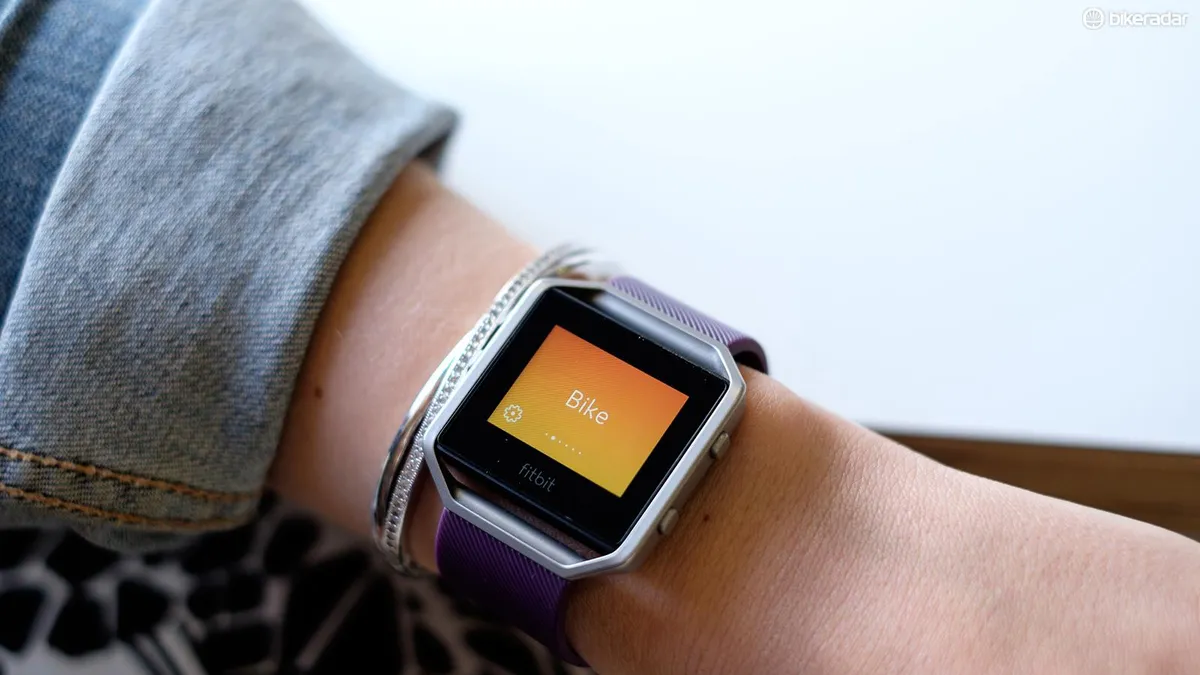
For a basic post-workout overview of time spent in each heart rate zone, plus continual monitoring of your resting heart rate to see how your fitness has improved over time, the Blaze has you covered. The accuracy of the HR reading shouldn't be an issue if you simply want to track overall fitness trends with consistent wear.
More serious athletes seeking a device to aid training should probably invest in a wearable that's specific to their needs. Chest straps are arguably more accurate in comparison to wrist-based tracking devices, and a more reliable training partner if you're wanting to indulge in zone-specific training.
Strava integration
Configuring the Blaze to integrate and upload data to Strava is painless – the two play very nicely together.
Connected GPS enables the Blaze to piggyback the location services on your smartphone. For those that like to travel light, this could be a turn-off; however, if you're anything like me, your smartphone doesn't leave your side, period. The lack of integrated GPS also means you can squeeze more juice out of the battery life and have a less clunky looking bit of kit on your wrist. Put the Blaze next to the Surge and I know which one I'd prefer to be wearing all day.
Post-ride you'll get a summary on your wrist of calories burned, elevation, distance travelled, average / max speed and average / max heart rate BPM, as well as the ride auto-uploaded to Strava. Activities tracked directly from the Strava app or manually added on the website will also contribute to your daily Fitbit stats by syncing seamlessly.
Side-by-side dashboard comparison of Fitbit vs Strava show small inconsistencies. Distance and average heart rate were pretty much the same for both; however, estimates for my calorie burn, average speed and elevation were higher in the Strava overview. My guess is that the Fitbit doesn't take into account stop times like Strava does, and that this skews the data a little.
While deeper analysis of ride / run stats is best left to Strava to handle, Fitbit does an exceedingly good job of presenting top-level info in a visually beautiful, accessible format that's perfect for the recreational cyclist, runner or fitness enthusiast.
Smart tracking, multi-sport and notifications
Multisport is a huge plus point if you're someone who mixes up your training. You're able to set up to seven activities to be exercise shortcuts that can be tracked directly from your wrist - yoga, martial arts and tennis to name a few. I found it slightly annoying that rowing wasn't included as a multi-sport shortcut, especially when an erg is usually a standard bit of kit in a commercial gym, but despite this nuance, 'workout' mode can be used for anything that doesn't come as default.
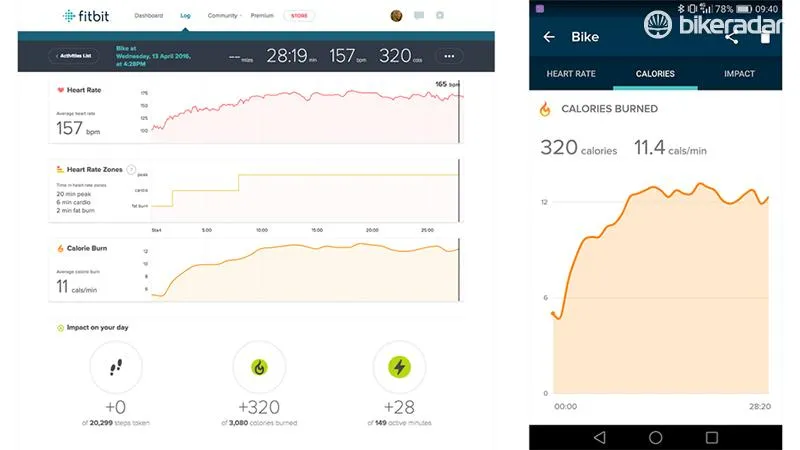
Outdoor cycling, walking, running, elliptical, aerobics and sport can also be auto-recognised, a feature labelled as 'smart tracking', after a user-specified time period. I was pleasantly surprised that after a 3hr hike my exercise stats had updated because smart tracking had kicked in.
Setting up your watch to receive call, text or calendar notifications is easy if you have a compatible smartphone. New notifications are prompted by a gentle vibration on your wrist, but annoyingly the watch face doesn't light up. Having to physically press a button to display a notification proves rather difficult if you're riding, and how are you meant to weigh up whether it's worth losing a potential PR on Strava to respond if you can't see the notification at a glance?
If you have 'quick view' activated in your device settings, the screen should be prompted wake up with a movement of your wrist. Curiosity led me to the FitBit forum to try to find out how it actually works - apparently there's a bit of a technique to it, and quite frankly, it all seems a little ludicrous. I don't want to teach myself to move my wrist in an unnatural way to see the time or read a notification.
It's worth reminding anyone interested in the Blaze that it's predominantly designed to be a fitness tracker and not a fully-fledged smart watch. Fitbit is sticking to what it does best and that's making fitness fun and doing so in style. It doesn't have the functionality or technology that a true iOS or Android wearable offers, so if you're expecting the Blaze to be an all encompassing smart-watch-meets-fitness-tracking hybrid, you'll be disappointed.
Conclusion: good option for multi-activity dabblers
If you're a serious athlete looking to do accurate heart-rate training, the Blaze won't cut it. The inconsistency with data would be annoying, and there's a lack of in-depth performance analysis. HIIT training would be impossible to carry out properly as it's likely the device would intermittently lose contact with your skin, and HR readings would be compromised.
In an ideal world, you'd be able to Bluetooth-pair a chest strap to the Blaze so the readings are not only precise, but can be read on compatible training equipment. Having my HR appear on the treadmill is something I love about wearing the Polar chest strap and it was definitely missed when trying to use the Blaze for interval training.
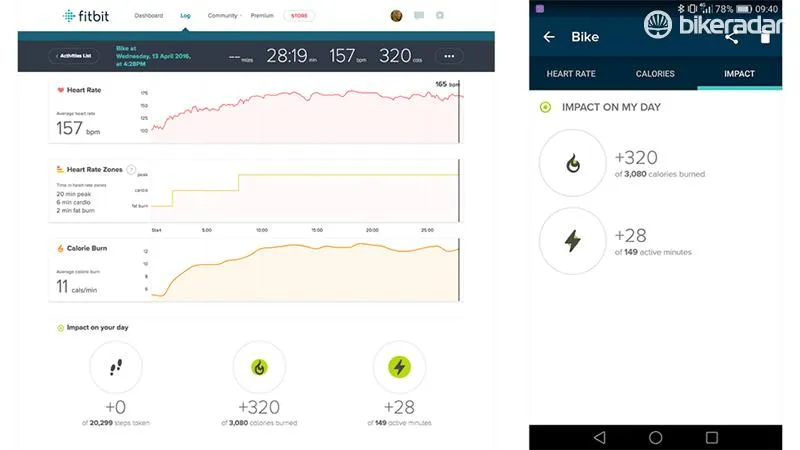
Those negatives aside, I've grown to love the Blaze. Yes, I feel like it's a novelty gadget but that's exactly what makes it such a great product if, like me, you like to dabble in a variety of activities rather than just cycling. I wanted a device that could track cycling, running, rowing and weight training and the Blaze meets these needs in a fashionable manner.
It encourages me to move more, and be more health conscious, all with an added sense of feeling like I belong to the thriving Fitbit community. Inviting my Fitbit peers into challenges, and earning badges for hitting fitness milestones, gives me an incentive to embrace a more active lifestyle. I've made more of a conscious effort to get out and about and it's rewarding to see lots of green icons on the watch when you've hit your personal targets for the day, or the colourful animation on your wrist for hitting your daily step count. For even more of an incentive to exercise, you can link any Fitbit device to the Bounts app where you can earn points to spend in online stores.
If you don't need the connected GPS and multisport the Blaze offers, you'd be better suited to investing in the Charge HR. You won't get the music control or text / calendar notifications, or a customisable device that looks more like an everyday watch, but it offers a very similar spec for a much cheaper price. For route tracking, you can initiate GPS recording from your mobile phone and then sync back to the Charge HR after.

